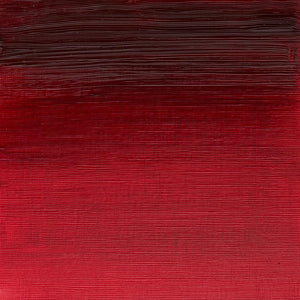
Alizarin crimson is a deep red pigment with a blue undertone. Known for its capacity to create a wide range of rich, permanent purples and browns, it is a colour with an eventful history.
It began as a dye thousands of years ago, made from a herbaceous madder plant native to Asia and southern Europe. The dye was prominently used for colouring clothes and traces were found in Ancient Egypt, Persia and the ruins of Pompeii. By the 7th century BC, the dye had been made into a lake pigment and was used across Europe, the Middle East and Asia. By this time the use of madder dye and pigment was widespread, but they remained costly and time consuming to produce.
In the early 19th century, the renowned English colourman George Field conducted extensive research into the madder plant and created a more efficient process to create the lake pigment. His findings were instrumental in the development of some of the early Winsor & Newton colours, allowing artists greater access to permanent materials.
In 1826, two French chemists, Jean-Jacques Colin and Pierre-Jean Robiquet, made further developments and isolated two separate dyes in madder: alizarin and purpurin. Then German chemists Carl Gräbe and Carl Liebermann distilled alizarin with zinc, leading them to discover anthraquinone in 1869. They were then able to synthesise the pigment from coal tar, making alizarin crimson the first natural dye to be synthesised. Synthetic alizarin crimson costs a fraction of the price to make and its consistency and lightfastness quickly made it a favourite red pigment for artists.
Customarily, pigments called alizarin crimson are made of the original lake pigment, making them closer to the original madder dye and those labelled permanent alizarin crimson are made with highly stable and permanent synthetic alternatives. Both are valuable and offer artists a wide range of dark red pigments.












![WN PWC KAREN KLUGLEIN BOTANICAL SET [FRONT]](http://www.winsornewton.com/cdn/shop/files/136444.jpg?crop=center&v=1740654068&width=20)
![WN PWC KAREN KLUGLEIN BOTANICAL SET [OPEN 2]](http://www.winsornewton.com/cdn/shop/files/136447.jpg?crop=center&v=1740654068&width=20)
![WN PWC ESSENTIAL SET [FRONT]](http://www.winsornewton.com/cdn/shop/files/137583.jpg?crop=center&v=1740762356&width=20)
![WN PWC ESSENTIAL SET [OPEN]](http://www.winsornewton.com/cdn/shop/files/137581.jpg?crop=center&v=1740762356&width=20)
![W&N GALERIA CARDBOARD SET 10X12ML [B014096] 884955097809 [FOP]](http://www.winsornewton.com/cdn/shop/files/138855.jpg?crop=center&v=1740761853&width=20)
![W&N GALERIA CARDBOARD SET 10X12ML 884955097809 [OPEN]](http://www.winsornewton.com/cdn/shop/files/138856.jpg?crop=center&v=1740761853&width=20)

![W&N PROMARKER 24PC STUDENT DESIGNER 884955043295 [FRONT]](http://www.winsornewton.com/cdn/shop/files/78674_d4d78a69-7150-4bf4-a504-3cb5304b0f80.jpg?crop=center&v=1721326116&width=20)

![W&N PROFESSIONAL WATER COLOUR TYRIAN PURPLE [SWATCH]](http://www.winsornewton.com/cdn/shop/files/136113.jpg?crop=center&v=1724423390&width=20)
![W&N WINTON OIL COLOUR [COMPOSITE] 37ML TITANIUM WHITE 094376711653](http://www.winsornewton.com/cdn/shop/files/9238_5073745e-fcfe-4fad-aab4-d631b84e4491.jpg?crop=center&v=1721326117&width=20)
![W&N WINTON OIL COLOUR [SPLODGE] TITANIUM WHITE](http://www.winsornewton.com/cdn/shop/files/131754_19b392ee-9bf6-4caf-a2eb-0356ec1c660a.jpg?crop=center&v=1721326118&width=20)